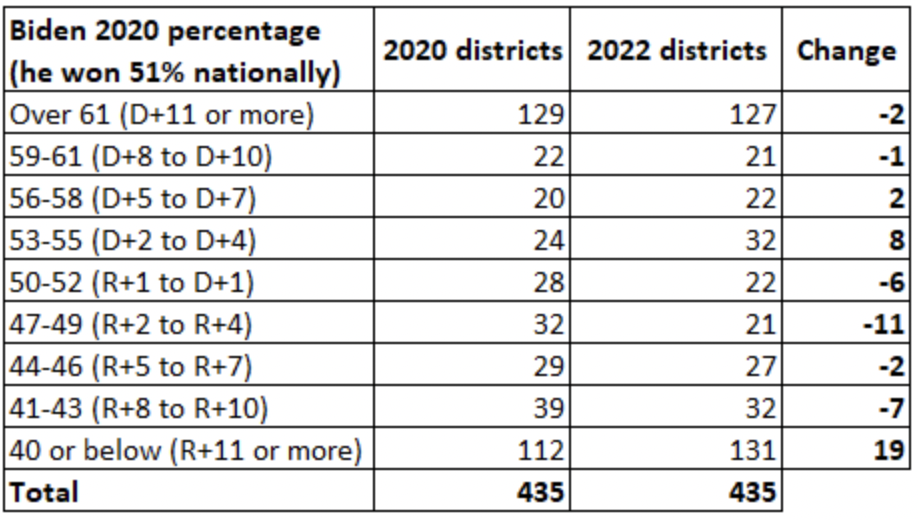University of Virginia Center for Politics analysts concluded that House Republicans benefit from the congressional maps that emerged from the redistricting process.
The Center for Politics on Thursday acknowledged that while President Joe Biden won 226 districts and former President Donald Trump won 209 on the old maps, the maps have now changed to 224-211 Biden. But, “the overall map still has a Republican tint.”

Chart of President Joe Biden’s 2020 performance, old versus new districts from University of Virginia Center for Politics’s Sabato’s Crystal Ball email blast.
The table indicated the total number of battleground districts decreased this cycle — districts that are typically rated within the R+4 to D+4 ratio. In the last cycle, there were 85 battleground districts, whereas there are only 75 this cycle after the redistricting — accounting for 17 percent of the seats.
The number of seats rated R+2 to R+4 also declined from 32 to 31, meaning the seats were distributed to other ratings. The University of Virginia Center noted that Texas was a major factor — which would ultimately “help limit Republican damage in a future bad election cycle.”
The Center for Politics explained the 131 “super-safe Republican districts” and 127 “super-safe Democratic seats”:
— The number of super-safe Republican districts — those where Biden won 40% or less — spiked from 112 to 131. One of the drivers of this increase was the Republican gerrymander of Texas, where mapmakers focused on shoring up current Republican seats: The number of seats where Biden received 40% or less increased from 11 to 20 in the Lone Star State (the comparison is slightly skewed because Texas also added 2 extra seats through reapportionment, but the difference is still stark).
— The number of super-safe Democratic seats, 127, is similar to the Republican total and down slightly from the current maps. Democratic gerrymandering contributed to this slight decline: For instance, Democrats in Nevada reduced the Biden share in Rep. Dina Titus’s (D, NV-1) district from 61.5% to 53.2% in order to shore up 2 other Nevada Democrats. The 3 seats the Democrats hold in the Silver State are now all vulnerable in a Republican wave, although Democrats also should have a better chance to reclaim any lost seat(s) in future elections. Overall, the D+2 to D+4 grouping expanded in size from 24 to 32.
…
— There are 211 seats where Biden received 49% of the vote or less, while there are 202 where he won 53% or more. This is another indicator of a Republican edge on the overall map. There are 22 in the middle of the range, the ones where Biden got between 50%-52% of the vote.
After striving to win back the House in 2020, the Republicans left the Democrats with the slimmest majority in modern history and gave themselves the upper hand in the midterms.
For Republicans, winning the majority will require a net gain of only five seats in November, and much is on the line in both the House and the Senate. Losing either could mean the Democrats and President Joe Biden will have a more challenging time passing their agenda items before the next presidential election.
Jacob Bliss is a reporter for Breitbart News. Write to him at jbliss@breitbart.com or follow him on Twitter @JacobMBliss.

COMMENTS
Please let us know if you're having issues with commenting.